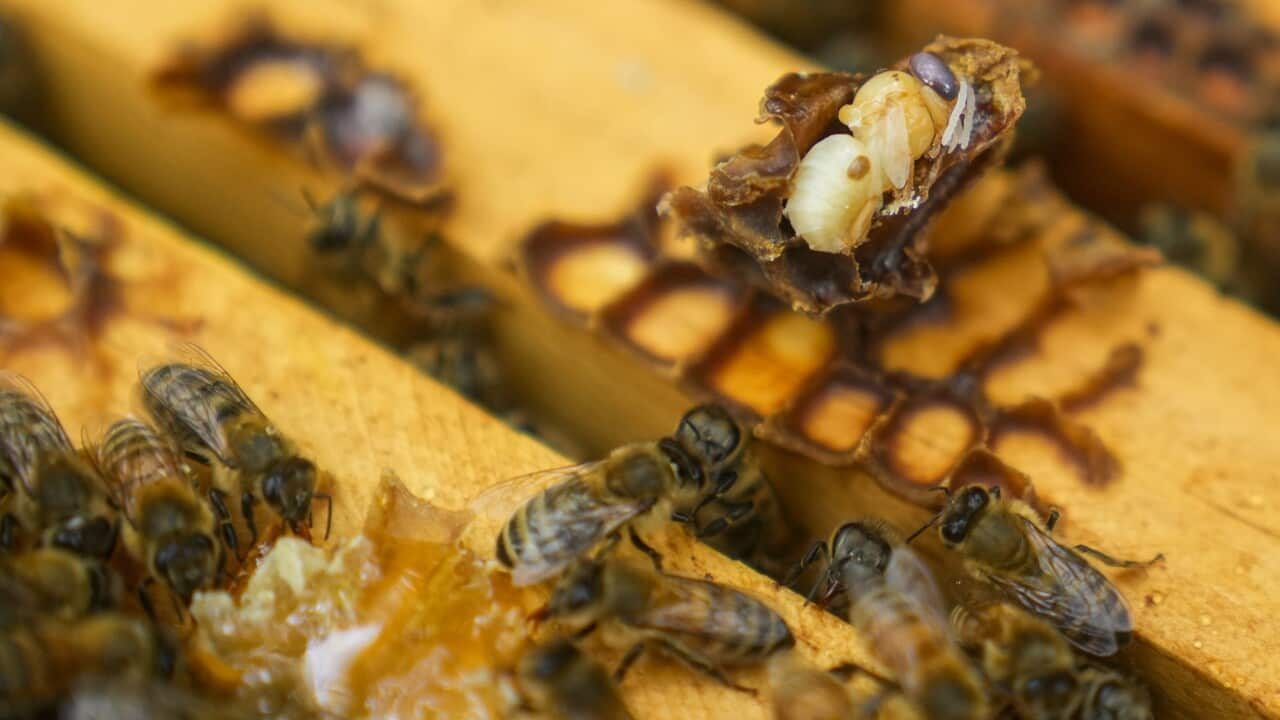Italian
Nel cuore del Northern Territory si trova il bacino dell'Amadeus. Si estende per 170.000 chilometri quadrati attraverso il deserto centrale e sconfina nel Western Australia. I locali lo conoscono come una miniera d'oro per antichi tesori, tra cui alcune delle scoperte di fossili più rari al mondo.
“To a geologist or a palaeontologist …it’s a bit like a lolly shop so it’s a case of you know what colour jelly bean do I want today alright I’ll go look for an arthropod in this area and see how it pans out.”
È qui che il cacciatore di fossili amatoriale Patrick Nelson ha fatto quella che potrebbe essere una grande scoperta scientifica.
“I went out one weekend for a day trip with a bit of an idea that there might be some sort of evidence of ancient life in the area so I ventured out there and walked around in the broad of day for a couple of hours and I was just about to head back to my car when I noticed at my foot lev el was an odd arrangement in a rock that sort of arrested me and so in the back of my mind it was different from the trilobites and molluscs and other things that I’d found in the Amadeus Basin while walking around in the past two years this was different a different form I didn’t know what it was so I thought it merits scientific inquiry so I’ve collected it and brought it home.”
L'esatta posizione in cui è stato trovato il fossile è stata tenuta segreta per garantire l'integrità scientifica del sito.
“We wouldn’t want that field disturbed unnecessarily by souvenir hunters or people with commercial interests that could sort of mess it up a bit you know humans have this natural tendency to be curious and to collect things and uh to my thinking that would jeopardise the scientific inquiry.”
Milioni di anni fa il bacino fu sommerso dal mare.
Si ritiene che il fossile possa essere l'anello mancante in una specie di artropodo, un organismo simile ad un insetto, che viveva nel bacino quando era coperto dall’acqua.
Da allora, da dove è stato rinvenuto è stato portato al Megafauna Central Museum di Alice Springs, dove verrà analizzato.
Il dottor Adam Yates, curatore anziano del reparto Terra e Scienza del museo, afferma che è la prima volta che viene trovato un fossile di questa era.
“It’s a first for the Northern Territory it would actually fill a gap in the fossil record because we have older ones and we have newer ones but we have nothing from this particular time period that is represented by the rocks it was discovered in so it would actually fill in this big gap and it’s a significant gap because it charts the change from a particular group of arthropods that were living in the sea to them moving into fresh water and then onto land and so it was during that transition period that we have no fossils and our fossil would fall into that gap.”
Il dottor Yates afferma che il museo ha avuto un calo nel numero di turisti a causa del coronavirus.
“The numbers are definitely down, down pre coronavirus and that makes sense because we don’t have the international visitors or the interstate visitors it’s as simple as that.”
Si augura che il fossile sia un’attrazione per i turisti mentre il Northern Territory si prepara ad aprire i suoi confini ai visitatori di altri stati nelle prossime due settimane.
“Going into the future we could be putting together a temporary display that will display this and other important new fossils that have been donated to the museum in the last year or so.”
Il dottor Yates si augura che questa scoperta non sia l’ultima nella regione.
“I sincerely hope there is more than just this one single individual and that we may actually be able to get to understand the whole ecosystem that this animal lived in with some of the other species that lived alongside it and just some more examples of the same kind of animal.”
English
A fossil believed to be 460 million years old has been found in central Australia.
It could prove to be a significant scientific discovery that could also draw tourists to the region, as it struggles to return to normality following strict coronavirus restrictions.
Deep in the heart of the Northern Territory lies the Amadeus Basin.
Stretching 170,000 square kilometres across the central desert and extending into Western Australia, locals know it as a gold mine for ancient treasures - including some of the world’s rarest fossil discoveries.
“To a geologist or a palaeontologist …it’s a bit like a lolly shop so it’s a case of you know what colour jelly bean do I want today alright I’ll go look for an arthropod in this area and see how it pans out.”
It was here, amateur fossil hunter Patrick Nelson made what could be a major scientific discovery.
“I went out one weekend for a day trip with a bit of an idea that there might be some sort of evidence of ancient life in the area so I ventured out there and walked around in the broad of day for a couple of hours and I was just about to head back to my car when I noticed at my foot lev el was an odd arrangement in a rock that sort of arrested me and so in the back of my mind it was different from the trilobites and molluscs and other things that I’d found in the Amadeus Basin while walking around in the past two years this was different a different form I didn’t know what it was so I thought it merits scientific inquiry so I’ve collected it and brought it home.”
The exact location in which the fossil was found has been kept a secret to ensure the scientific integrity of the site.
“We wouldn’t want that field disturbed unnecessarily by souvenir hunters or people with commercial interests that could sort of mess it up a bit you know humans have this natural tendency to be curious and to collect things and uh to my thinking that would jeopardise the scientific inquiry.”
Millions of years ago, the basin was submerged in sea water.
It’s believed the fossil could be the missing link in a species of arthropod, or insect like creature, that lived in the basin when it was underwater.
It’s since been taken from where it was found to the Megafauna Central Museum in Alice Springs, where it will be analysed.
The museum’s Senior Earth and Science Curator Doctor Adam Yates says it’s the first time they’ve found a fossil from this period in time.
“It’s a first for the Northern Territory it would actually fill a gap in the fossil record because we have older ones and we have newer ones but we have nothing from this particular time period that is represented by the rocks it was discovered in so it would actually fill in this big gap and it’s a significant gap because it charts the change from a particular group of arthropods that were living in the sea to them moving into fresh water and then onto land and so it was during that transition period that we have no fossils and our fossil would fall into that gap.”
Dr Yates says that the museum has had dwindling tourists’ numbers because of coronavirus.
“The numbers are definitely down, down pre coronavirus and that makes sense because we don’t have the international visitors or the interstate visitors it’s as simple as that.”
He hopes the fossil will be a drawcard for visitors as the Northern Territory prepares to open its borders to more interstate visitors in the next couple of weeks.
“Going into the future we could be putting together a temporary display that will display this and other important new fossils that have been donated to the museum in the last year or so.”
Dr Yates hopes this discovery won’t be his last in the region.
“I sincerely hope there is more than just this one single individual and that we may actually be able to get to understand the whole ecosystem that this animal lived in with some of the other species that lived alongside it and just some more examples of the same kind of animal.”
Report by Aneeta Bhole
Le persone in Australia devono stare ad almeno 1,5 metri di distanza dagli altri. per verificare i limiti imposti sugli assembramenti.
I test per il coronavirus ora sono ampiamente disponibili in tutta Australia. Se avete sintomi da raffreddore o influenza, richiedete di sottoporvi ad un test chiamando telefonicamente il vostro medico, oppure contattate la hotline nazionale per le informazioni sul Coronavirus al numero 1800 020 080.
La app di tracciamento del coronavirus del governo federale COVIDSafe è disponibile e può essere scaricata dall’app store del vostro telefono.
SBS è impegnata nell'informare tutte le comunità d'Australia sugli ultimi sviluppi legati al COVID-19. Notizie e informazioni sono disponibili in 63 lingue all'indirizzo .







